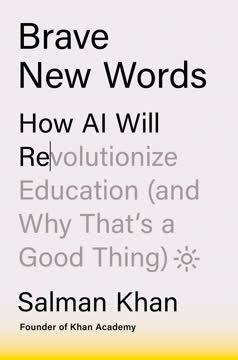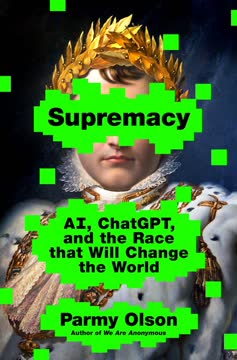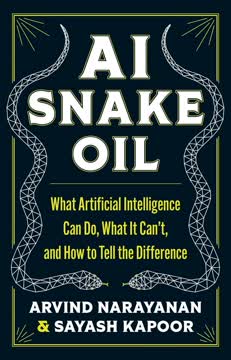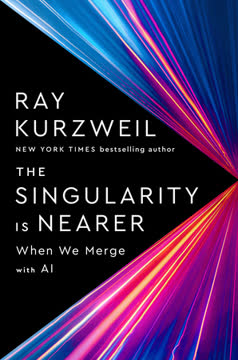Key Takeaways
1. Information is about connection, not just representation
Information doesn't necessarily inform us about things. Rather, it puts things in formation.
Information creates realities. Throughout history, information has been used not just to represent existing realities, but to create new ones by connecting disparate elements. This is true from DNA in biology to religious texts in human societies. Information technologies like writing, printing, and now computers have dramatically expanded our ability to create and maintain large-scale cooperative networks.
- Examples of information creating realities:
- DNA connecting cells into organisms
- Religious texts connecting believers into communities
- Legal documents connecting individuals into nations
- Computer code connecting devices into networks
Understanding information as a connective force helps explain phenomena like the power of myths, the rise of bureaucracies, and the potential impact of AI on human societies.
2. Stories and myths shape human cooperation on a massive scale
For tens of thousands of years, Sapiens built and maintained large networks by inventing and spreading fictions, fantasies, and mass delusions—about gods, about enchanted broomsticks, about AI, and about a great many other things.
Myths enable large-scale cooperation. Humans are unique in their ability to create and believe in shared fictions, which allows for cooperation beyond small kinship groups. These shared myths - whether religious, national, or ideological - have been crucial in building large societies and civilizations.
- Functions of shared myths:
- Create common identities
- Establish shared goals
- Justify social hierarchies
- Provide meaning and purpose
However, while myths are powerful tools for cooperation, they can also be sources of conflict and oppression when different groups hold incompatible beliefs. The challenge for modern societies is to harness the connective power of shared stories while maintaining flexibility and tolerance for diverse perspectives.
3. Bureaucracy and documents centralized power but limited privacy
Documents, archives, forms, licenses, regulations, and other bureaucratic procedures have changed the way information flows in society, and with it the way power works.
Bureaucracy changed information flow. The rise of written documents and bureaucratic systems dramatically altered how information was collected, stored, and used in societies. This shift centralized power in new ways, but also created new limitations on privacy and individual autonomy.
- Key changes brought by bureaucracy:
- Centralization of information in archives
- Creation of standardized forms and procedures
- Rise of specialized bureaucratic classes
- Increased state capacity for taxation and control
While bureaucracy enabled more complex and efficient governance, it also created new forms of oppression and surveillance. The tension between bureaucratic efficiency and individual privacy remains a central challenge in the digital age.
4. Holy books and infallible sources often lead to human control
The attempt to invest all authority in an infallible superhuman technology led to the rise of a new and extremely powerful human institution—the church.
Infallibility breeds control. Throughout history, attempts to create infallible sources of truth - whether holy books, ideologies, or AI systems - have often led to increased human control rather than liberation from error. This paradox arises because infallible sources still require human interpretation and implementation.
- Examples of "infallible" sources leading to human control:
- Religious texts and priestly classes
- Political ideologies and party elites
- AI systems and tech companies
The lesson for the age of AI is that claims of algorithmic infallibility should be treated with skepticism, and human oversight and interpretation will remain crucial even as AI systems become more powerful.
5. Democracy relies on distributed information and self-correction
Democracy is a conversation with numerous participants, many of them talking at the same time. It can be hard to follow such a conversation.
Democracy is messy but resilient. Democratic systems are characterized by distributed information flows and strong self-correcting mechanisms. While this can make them appear chaotic or inefficient compared to more centralized systems, it also makes them more adaptable and resistant to catastrophic errors.
Key features of democratic information systems:
- Multiple independent information channels
- Freedom of speech and press
- Separation of powers
- Regular elections and peaceful transfers of power
The challenge for modern democracies is to maintain these distributed and self-correcting features in the face of new technologies that enable unprecedented centralization and control of information.
6. Computers are changing the nature of information networks
Unlike printing presses and radio sets, which were passive tools in human hands, computers are already becoming active agents that escape our control and understanding and that can take initiatives in shaping society, culture, and history.
Computers are active agents. The rise of computers and AI represents a fundamental shift in the nature of information networks. Unlike previous technologies, computers can make decisions and create new ideas independently of human input.
- Key differences between computers and previous technologies:
- Ability to process vast amounts of data
- Capacity for machine learning and self-improvement
- Potential for autonomous decision-making
- Creation of inter-computer realities
This shift raises profound questions about human agency, control, and the future of social and political systems built on human decision-making.
7. AI's alignment problem poses existential risks to humanity
The alignment problem turns out to be, at heart, a problem of mythology.
Aligning AI with human values is crucial. As AI systems become more powerful, ensuring that their goals and actions align with human values and interests becomes an existential challenge. This "alignment problem" is complex because it involves not just technical issues, but fundamental questions about human values and the nature of consciousness.
- Key aspects of the alignment problem:
- Defining human values in machine-readable terms
- Ensuring AI systems pursue intended rather than literal goals
- Maintaining human control over increasingly autonomous systems
- Addressing potential conflicts between AI and human interests
Solving the alignment problem may be the most important challenge facing humanity in the coming decades, as misaligned AI systems could pose existential risks even if they are not explicitly hostile to humans.
8. Computer biases can perpetuate and amplify human prejudices
AIs too have childhood experiences. Algorithms might even infect one another with their biases, just as humans do.
AI can amplify biases. While AI systems are often presented as objective and unbiased, they can actually perpetuate and amplify human prejudices present in their training data. This occurs because AI systems learn patterns from existing data, which often reflects historical biases and inequalities.
Examples of AI bias:
- Facial recognition systems performing poorly on darker skin tones
- Resume screening algorithms favoring male candidates
- Predictive policing systems targeting minority neighborhoods
Addressing AI bias requires not just technical solutions, but a deep examination of the social and historical contexts in which AI systems are developed and deployed.
9. Democracy faces new challenges in the age of AI and automation
If three years of high unemployment could bring Hitler to power, what might never-ending turmoil in the job market do to democracy?
AI disrupts democratic stability. The rapid pace of technological change, particularly in AI and automation, poses significant challenges to democratic systems. These challenges include potential mass unemployment, increased economic inequality, and the manipulation of public opinion through AI-driven information systems.
Potential threats to democracy from AI:
- Job displacement leading to social unrest
- Concentration of wealth and power in tech companies
- AI-powered surveillance and social control systems
- Manipulation of elections through targeted misinformation
Addressing these challenges will require new forms of democratic governance and economic organization that can adapt to rapid technological change while preserving core democratic values.
10. Preserving human agency is crucial as AI becomes more powerful
To guard against a plethora of unforeseeable problems, our best bet is to create living institutions that can identify and respond to the threats as they arise.
Human oversight remains essential. As AI systems become more powerful and autonomous, preserving human agency and oversight becomes increasingly crucial. This requires not just technical safeguards, but the development of new social and political institutions capable of governing AI systems.
Key principles for preserving human agency:
- Maintaining human control over critical decisions
- Ensuring transparency and accountability in AI systems
- Developing robust ethical frameworks for AI development
- Investing in human education and adaptability
The ultimate challenge is to harness the immense potential of AI while ensuring that it remains a tool for human flourishing rather than a threat to human autonomy and existence.
Last updated:
FAQ
What's Nexus: A Brief History of Information Networks from the Stone Age to AI about?
- Exploration of Networks: Nexus by Yuval Noah Harari delves into the evolution of information networks from ancient times to the present, examining their impact on human societies and power dynamics.
- Human Cooperation and Power: The book argues that humanity's ability to cooperate in large numbers has been pivotal in our dominance, but this power often lacks wisdom in its application.
- Impact of Technology: Harari discusses how various information technologies, from storytelling to AI, have influenced political systems, social structures, and the flow of information throughout history.
Why should I read Nexus: A Brief History of Information Networks from the Stone Age to AI?
- Understanding Modern Challenges: The book provides insights into contemporary issues such as ecological crises and the rise of AI, offering historical context for these challenges.
- Critical Perspective on Information: Harari encourages readers to critically assess the information they consume and the narratives shaping their beliefs, which is crucial in today's digital age.
- Engaging Narrative: Harari's writing style combines history, philosophy, and sociology, making complex ideas accessible and thought-provoking for a wide audience.
What are the key takeaways of Nexus: A Brief History of Information Networks from the Stone Age to AI?
- Power vs. Wisdom: Humans have accumulated immense power through information networks but often lack the wisdom to use it responsibly.
- Role of Stories: Stories are fundamental to human cooperation, enabling large societies but also leading to delusions and destructive ideologies.
- Self-Correcting Mechanisms: The book highlights the need for self-correcting mechanisms in institutions to balance truth pursuit with social order.
What are the best quotes from Nexus: A Brief History of Information Networks from the Stone Age to AI and what do they mean?
- “If we Sapiens are so wise, why are we so self-destructive?”: This quote questions humanity's wisdom despite our advancements and power.
- “Information is the glue that holds networks together.”: It emphasizes the critical role of information in forming and maintaining social structures.
- “The tendency to create powerful things with unintended consequences started not with the invention of the steam engine or AI but with the invention of religion.”: This suggests that human belief systems have historically led to both cooperation and conflict.
How does Yuval Noah Harari define information in Nexus: A Brief History of Information Networks from the Stone Age to AI?
- Connection Over Representation: Information is about creating connections between entities, not just representing reality.
- Intersubjective Reality: Harari introduces intersubjective realities, existing in shared beliefs and narratives rather than objective facts.
- Role in History: Information has been a driving force in shaping human history, influencing social structures and political systems.
What is the naive view of information according to Nexus: A Brief History of Information Networks from the Stone Age to AI?
- Optimistic Perspective: The naive view suggests more information leads to greater truth and wisdom.
- Limitations of the View: Harari critiques this, arguing that more information can lead to confusion and misinformation.
- Need for Curation: Effective curation is essential to ensure truth prevails over falsehoods in society.
How does Nexus: A Brief History of Information Networks from the Stone Age to AI relate to democracy and totalitarianism?
- Information Flow Differences: Democracies allow distributed information flow, while totalitarian systems centralize it.
- Self-Correcting Mechanisms: Democracies have strong self-correcting mechanisms for accountability, unlike totalitarian regimes.
- Historical Examples: The book uses examples like the Roman Empire to illustrate how information control shapes political power.
What role do stories play in human networks according to Nexus: A Brief History of Information Networks from the Stone Age to AI?
- Foundation of Cooperation: Stories enable large-scale human cooperation without personal relationships.
- Mythology vs. Bureaucracy: Stories inspire and unite, while bureaucratic systems manage larger populations.
- Potential for Delusion: Stories can create powerful bonds but also lead to collective delusions.
How does Yuval Noah Harari address the issue of errors in information networks in Nexus: A Brief History of Information Networks from the Stone Age to AI?
- Fantasy of Infallibility: Harari critiques the belief in infallible information sources, noting all systems are prone to error.
- Self-Correcting Mechanisms: Emphasizes the need for mechanisms to identify and rectify mistakes.
- Historical Context: Provides historical examples like witch hunts to illustrate error proliferation without correction systems.
How does Nexus: A Brief History of Information Networks from the Stone Age to AI relate to the rise of AI?
- New Information Networks: AI represents a new kind of information network that could replace traditional structures.
- Challenges to Democracy: AI could undermine democratic mechanisms and exacerbate power imbalances.
- Future Implications: Harari stresses careful consideration of AI's integration into society due to its potential to reshape governance.
What is the totalitarian ambition discussed in Nexus: A Brief History of Information Networks from the Stone Age to AI?
- Qin Empire's Totalitarianism: Describes the Qin Empire's control over life aspects as an early totalitarian example.
- Centralization and Surveillance: The regime's strict laws and surveillance measures maintained control.
- Historical Implications: This ambition led to economic problems and resentment, showing the unsustainability of extreme totalitarianism.
How does Nexus: A Brief History of Information Networks from the Stone Age to AI suggest we can regulate AI effectively?
- Institutional Oversight: Emphasizes the need for institutions to oversee and audit AI technologies.
- Public Engagement: Advocates for public involvement in AI regulation discussions.
- International Cooperation: Suggests international cooperation is necessary for effective AI regulation.
Review Summary
Nexus by Yuval Noah Harari explores the history of information networks from ancient times to AI. Readers found it thought-provoking and well-researched, praising Harari's ability to present complex ideas accessibly. The book focuses heavily on AI's potential dangers and impact on society. While some felt it was repetitive or overly pessimistic, many considered it a must-read for understanding technology's influence on our world. Critics noted that certain arguments lacked sufficient evidence, but overall, the book was highly recommended for its engaging content and timely insights.
Similar Books










Download PDF
Download EPUB
.epub digital book format is ideal for reading ebooks on phones, tablets, and e-readers.










